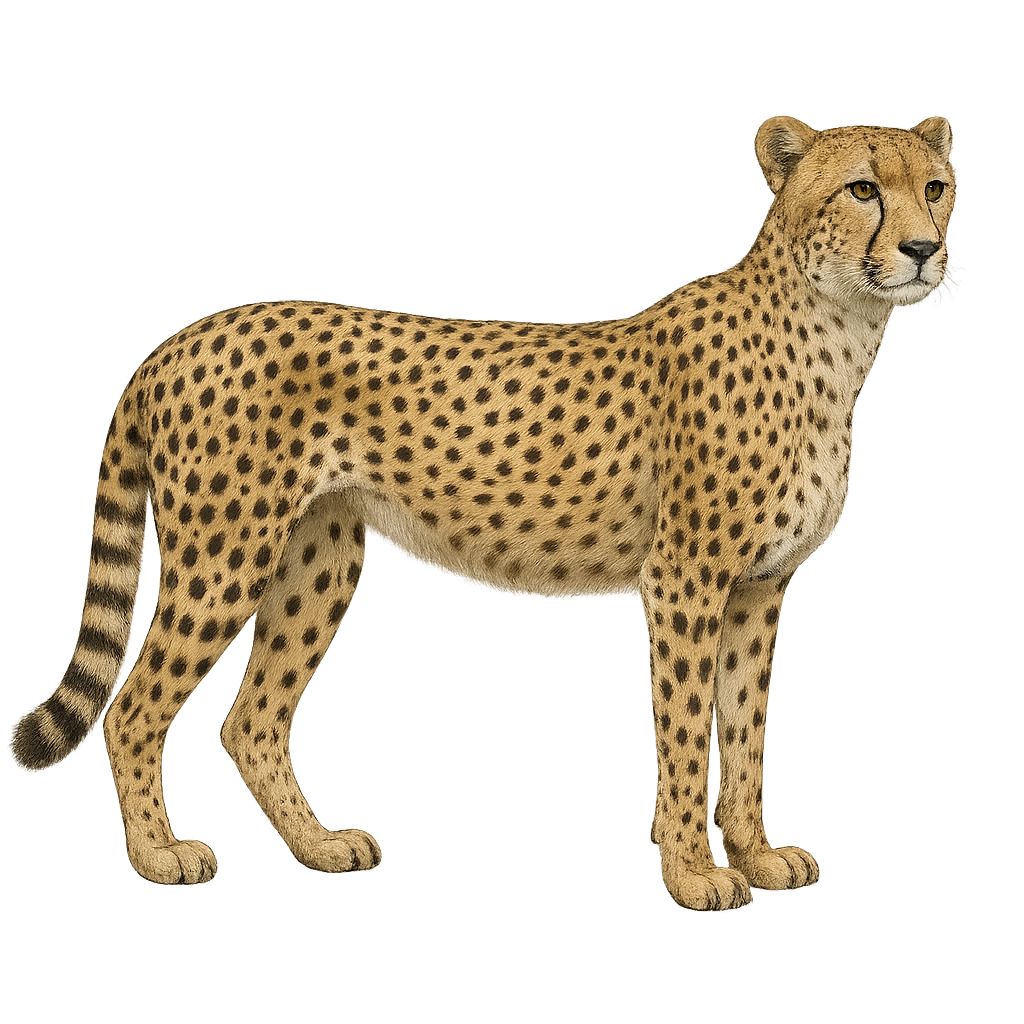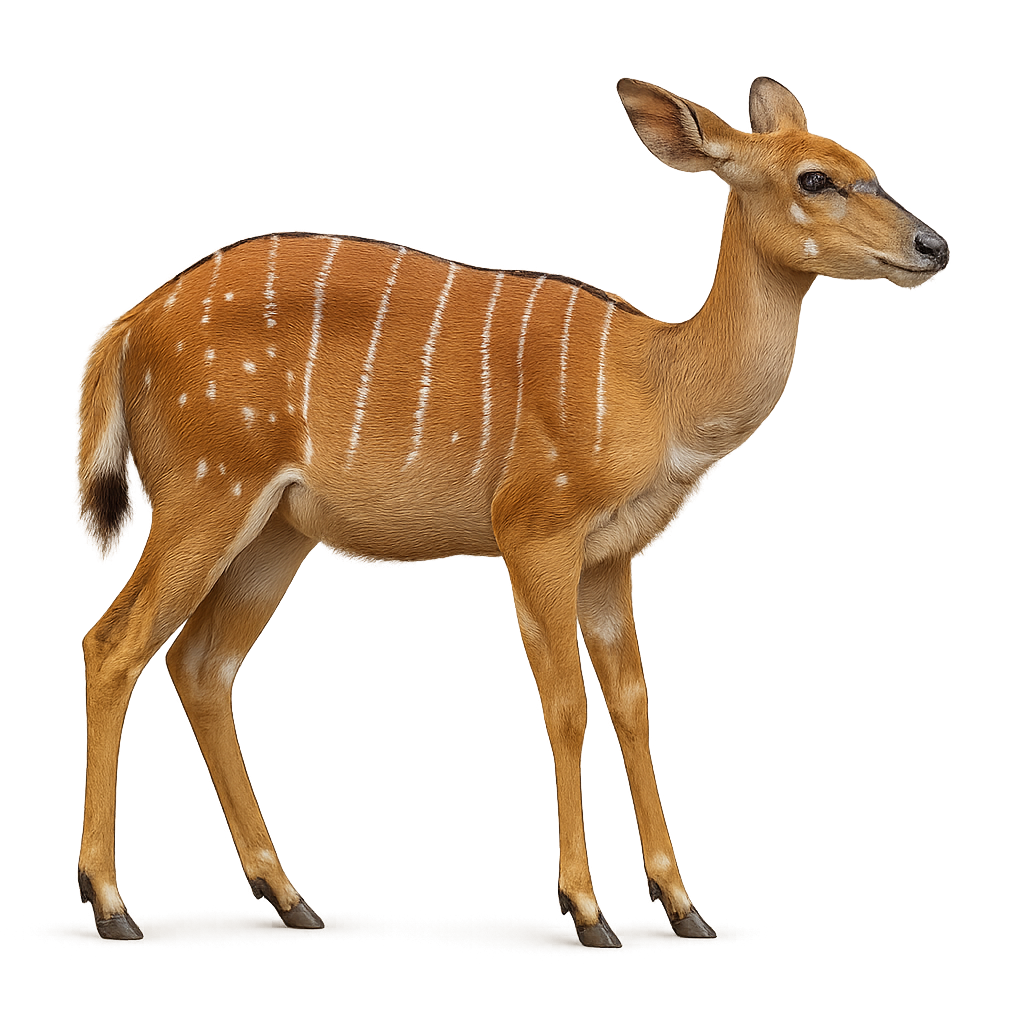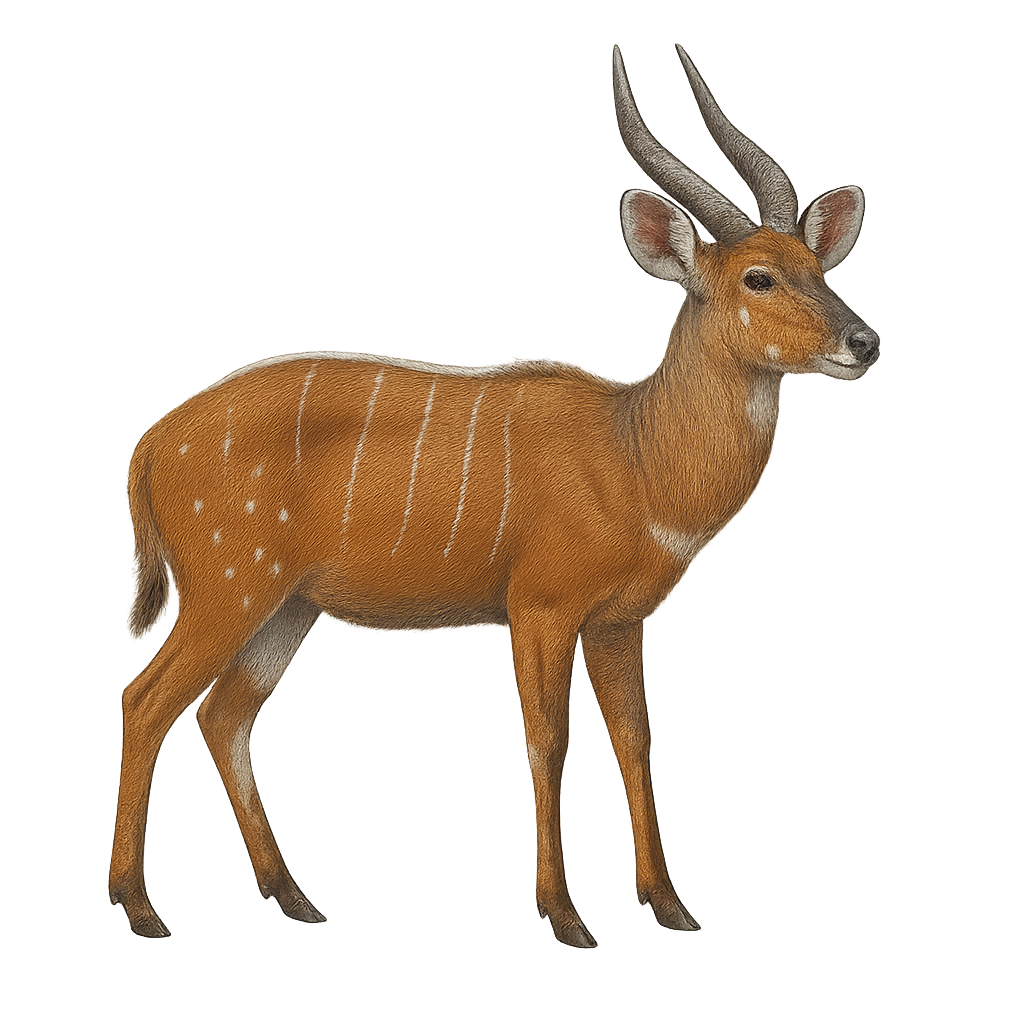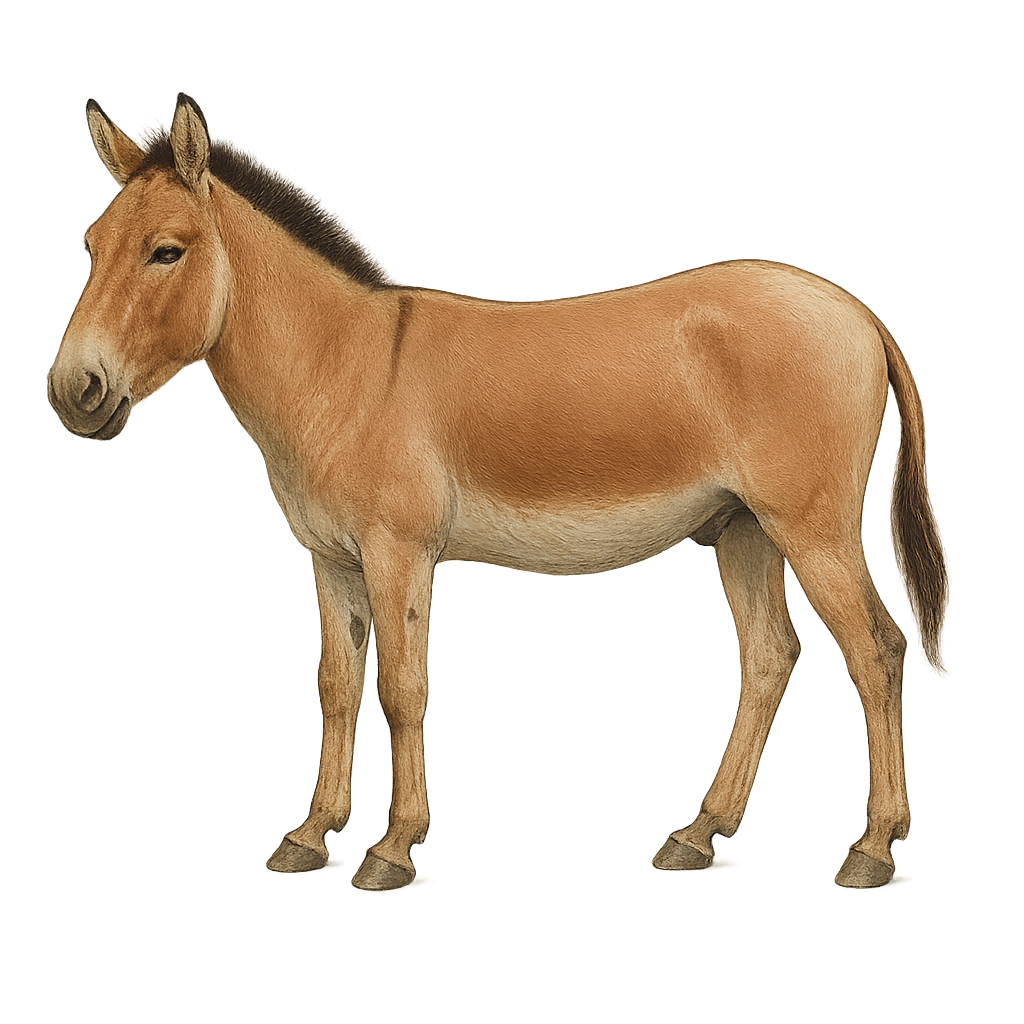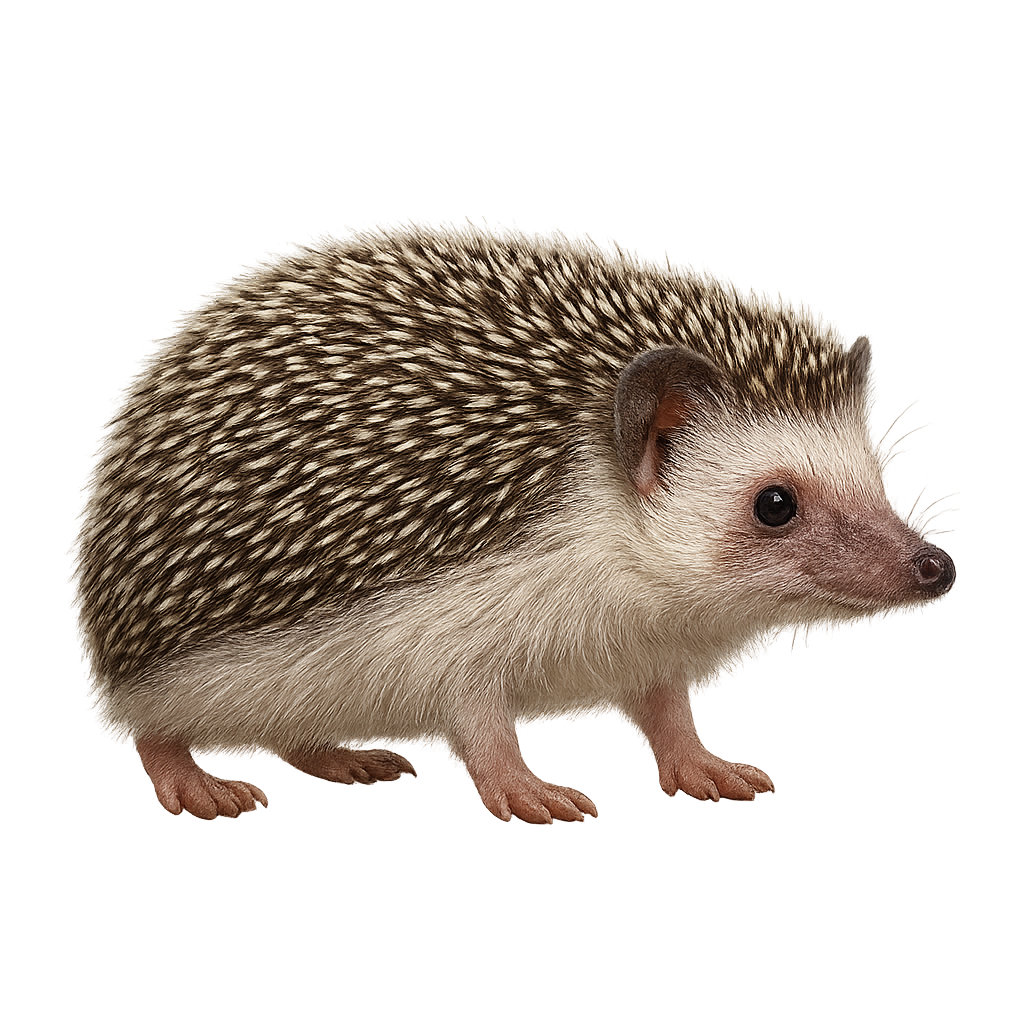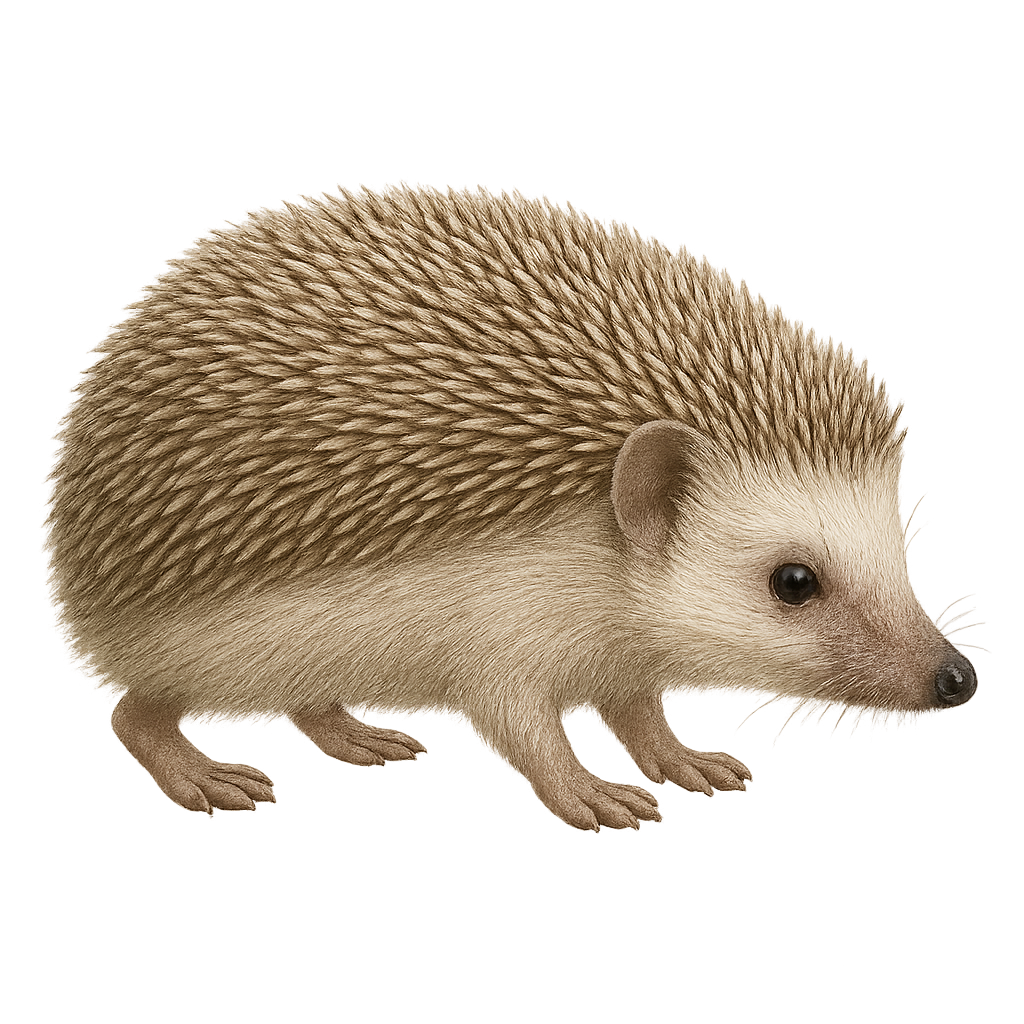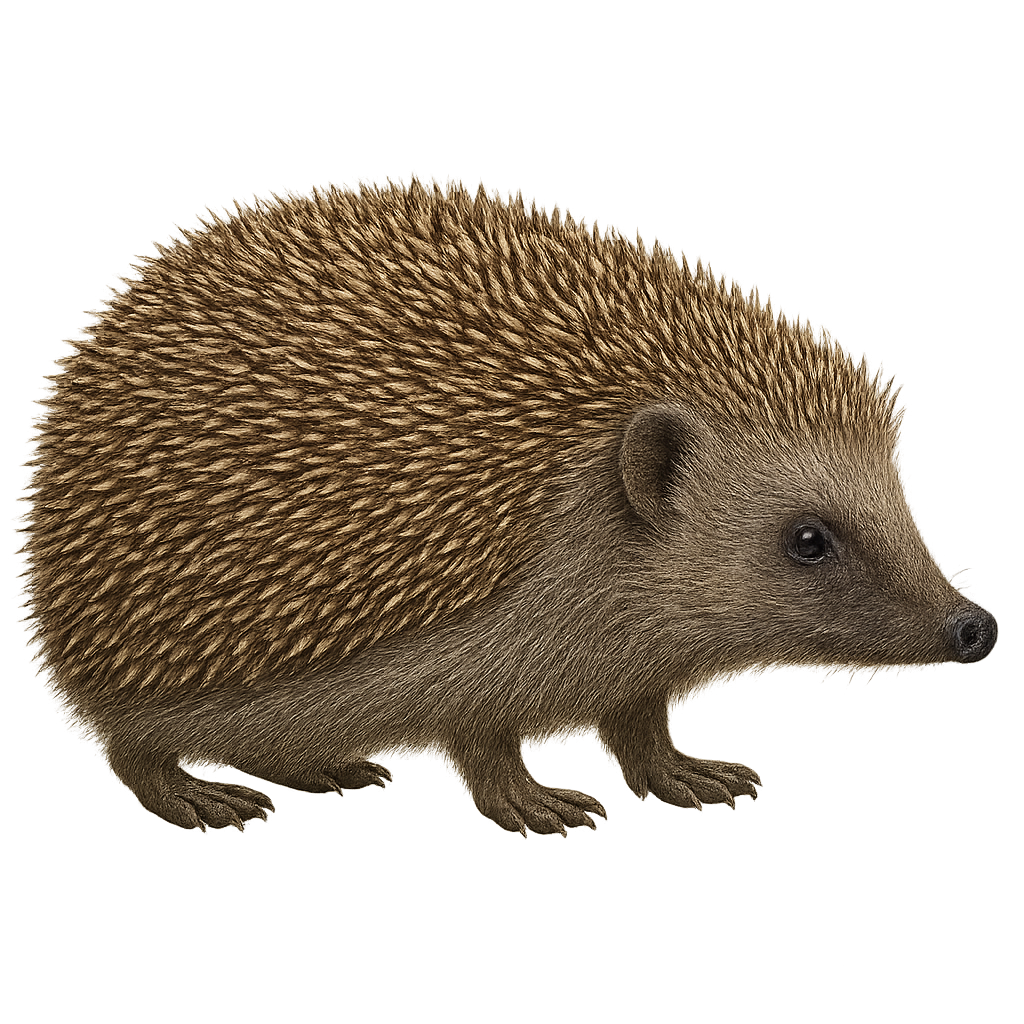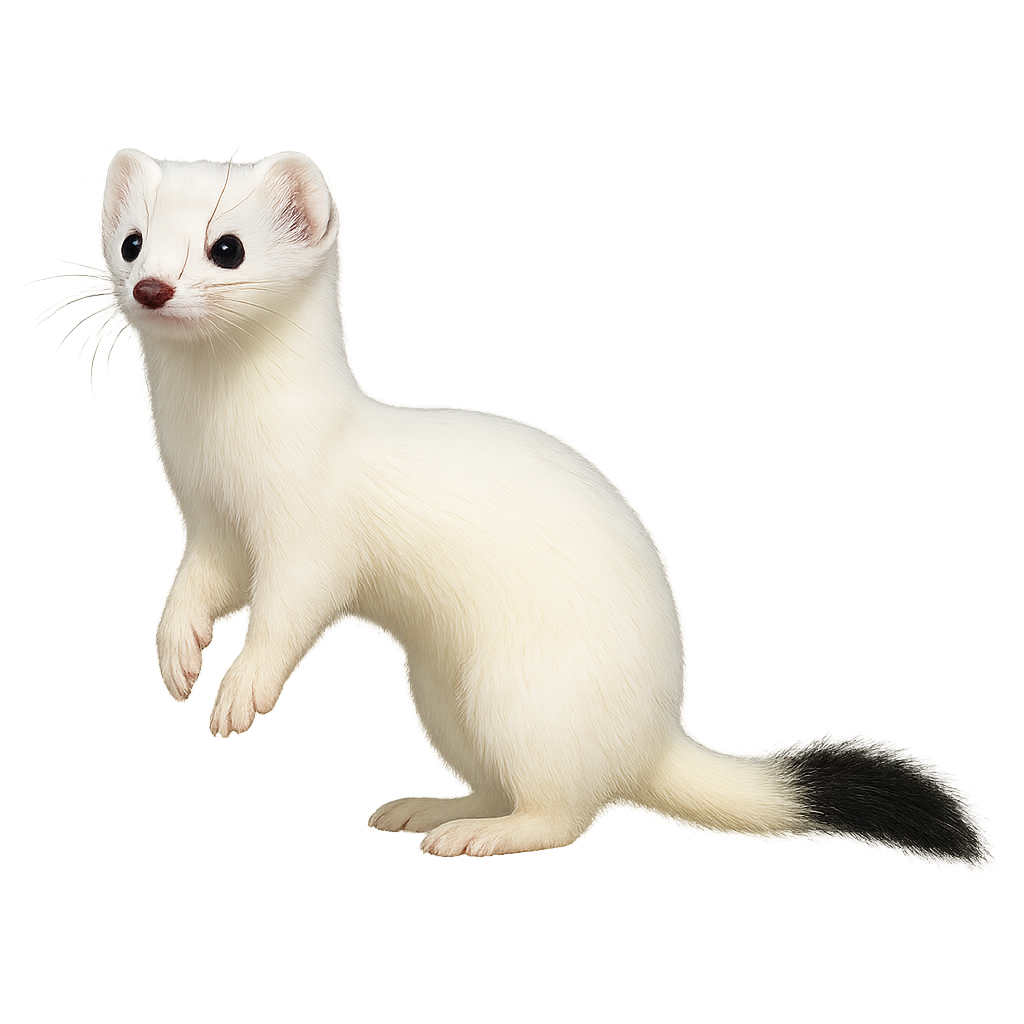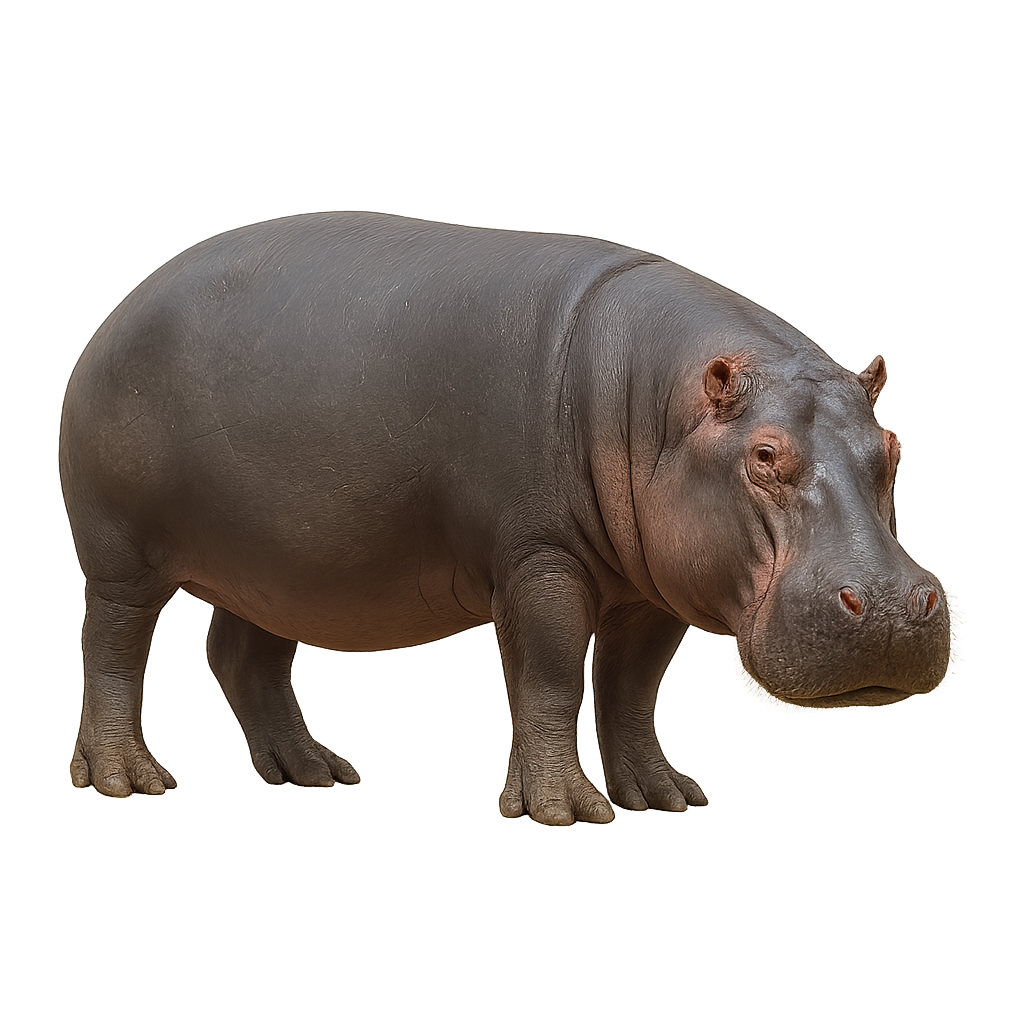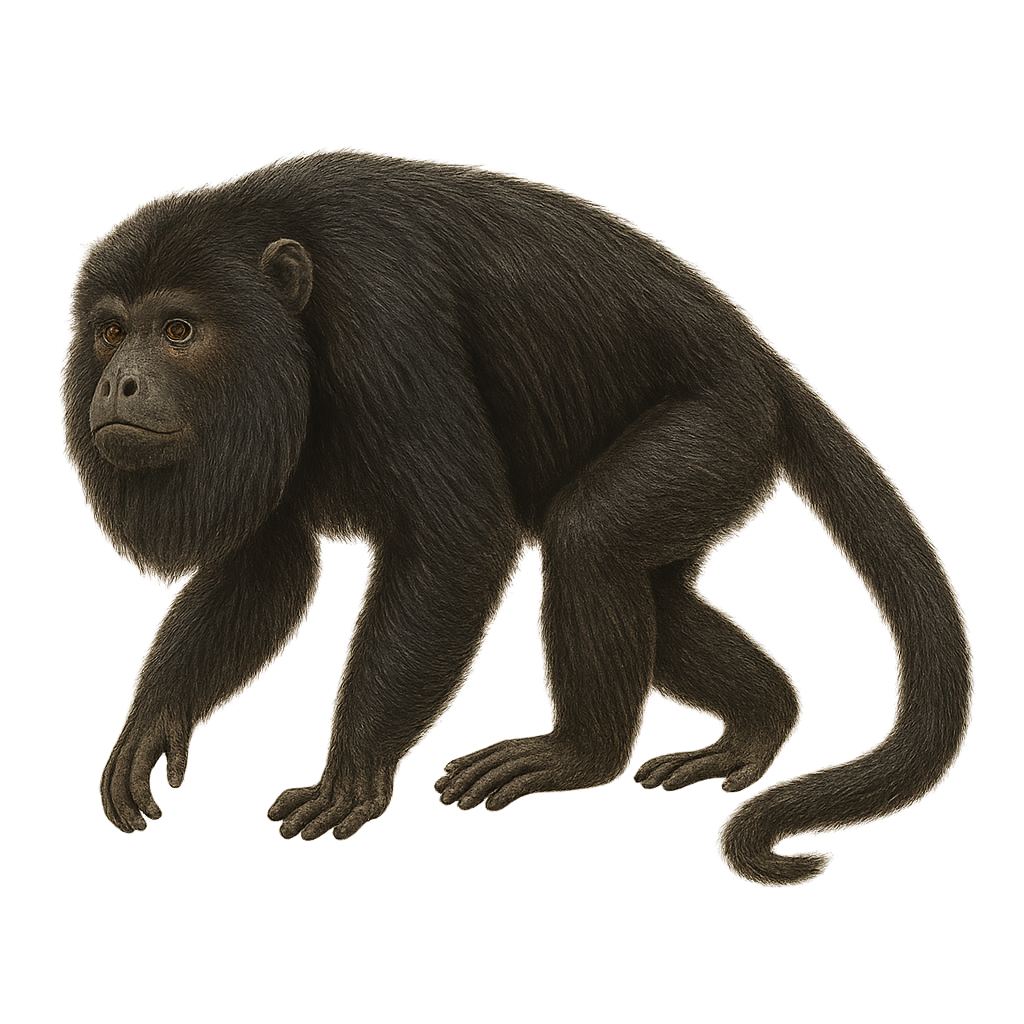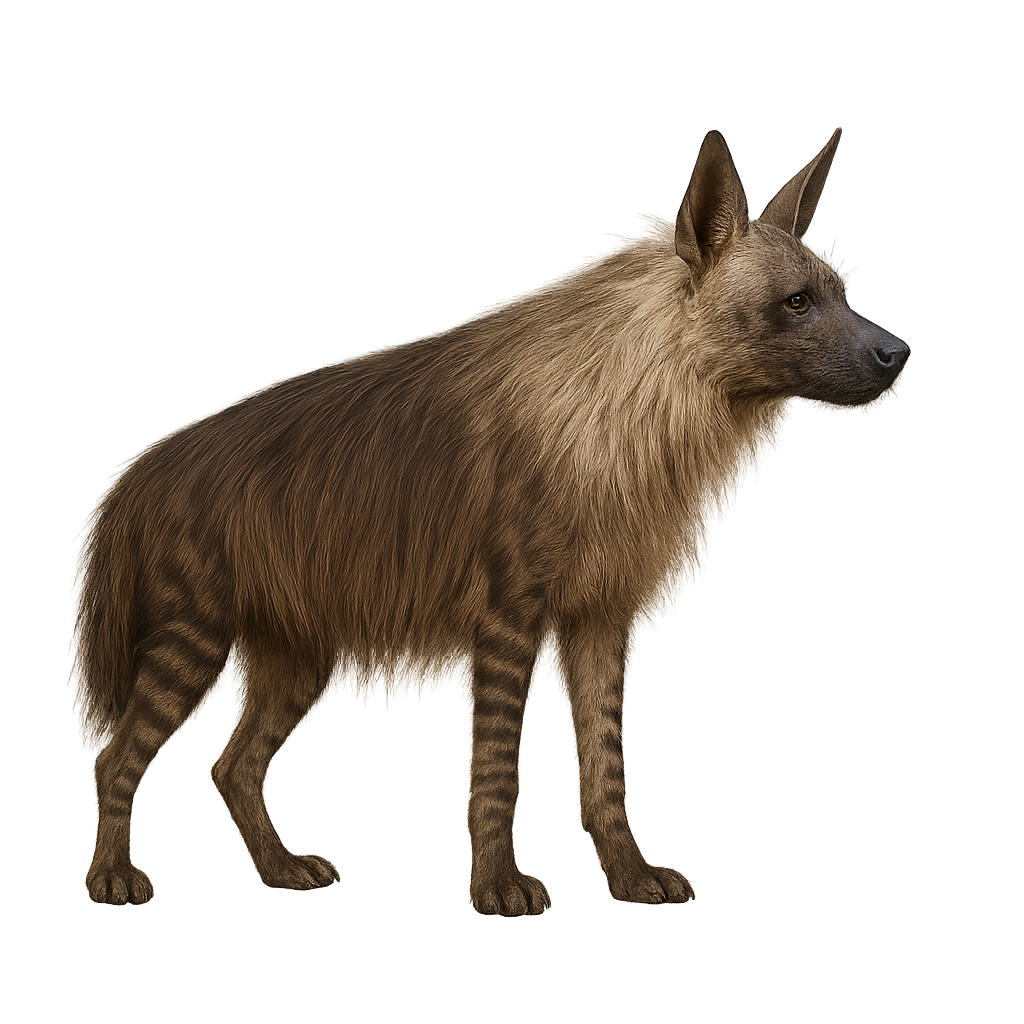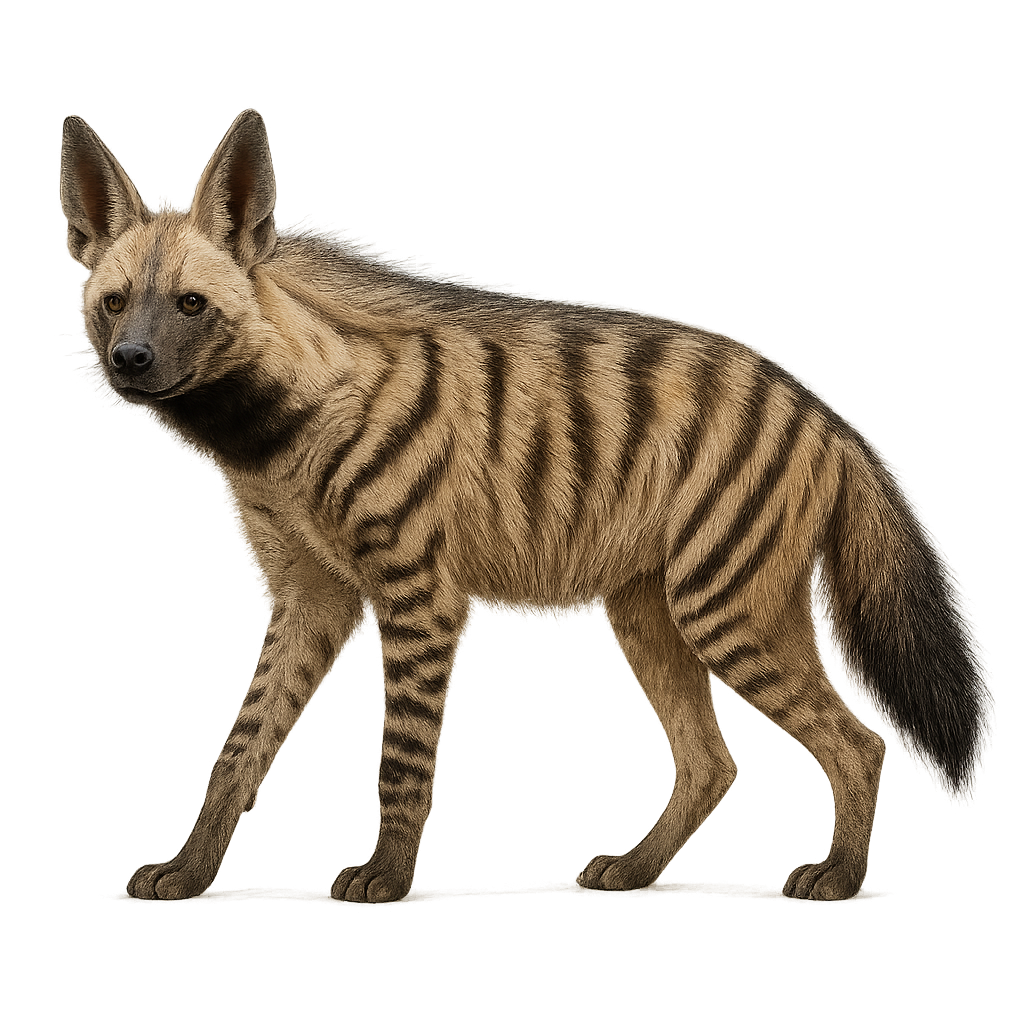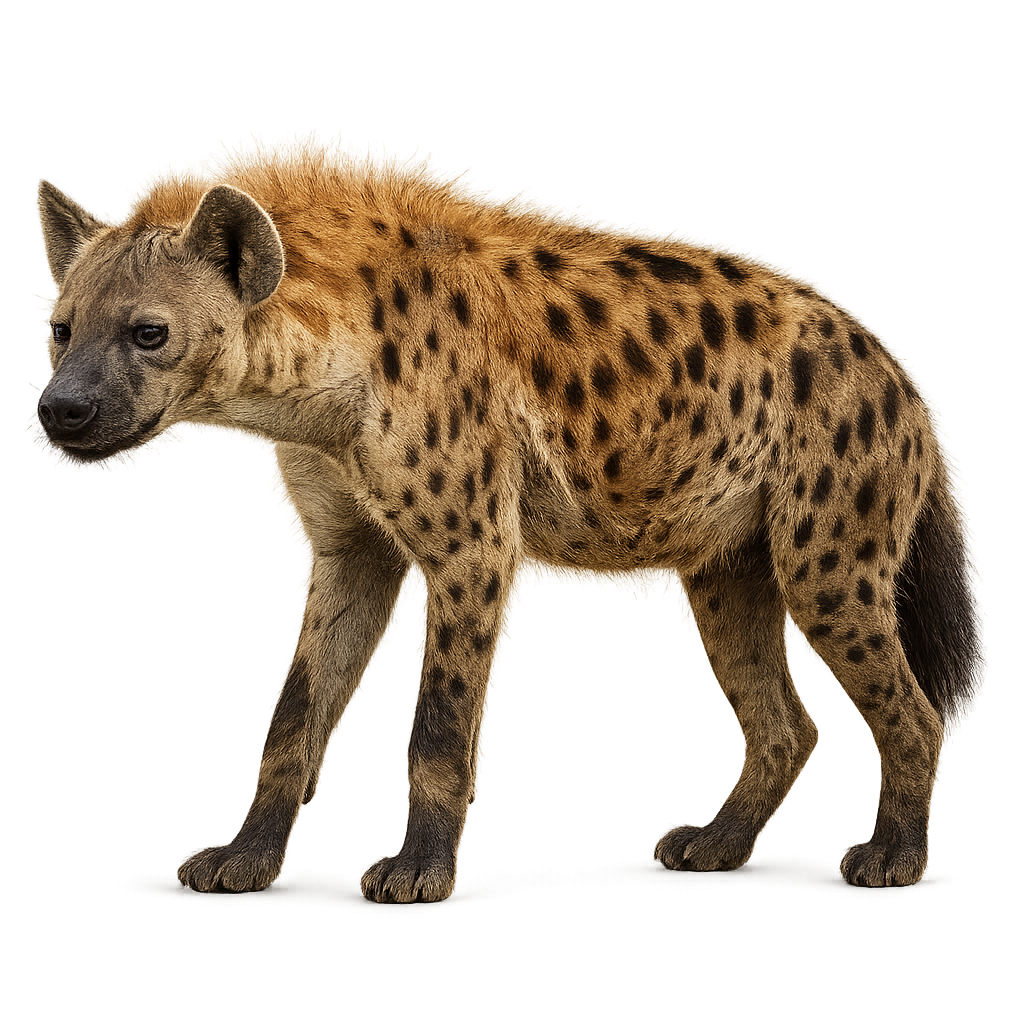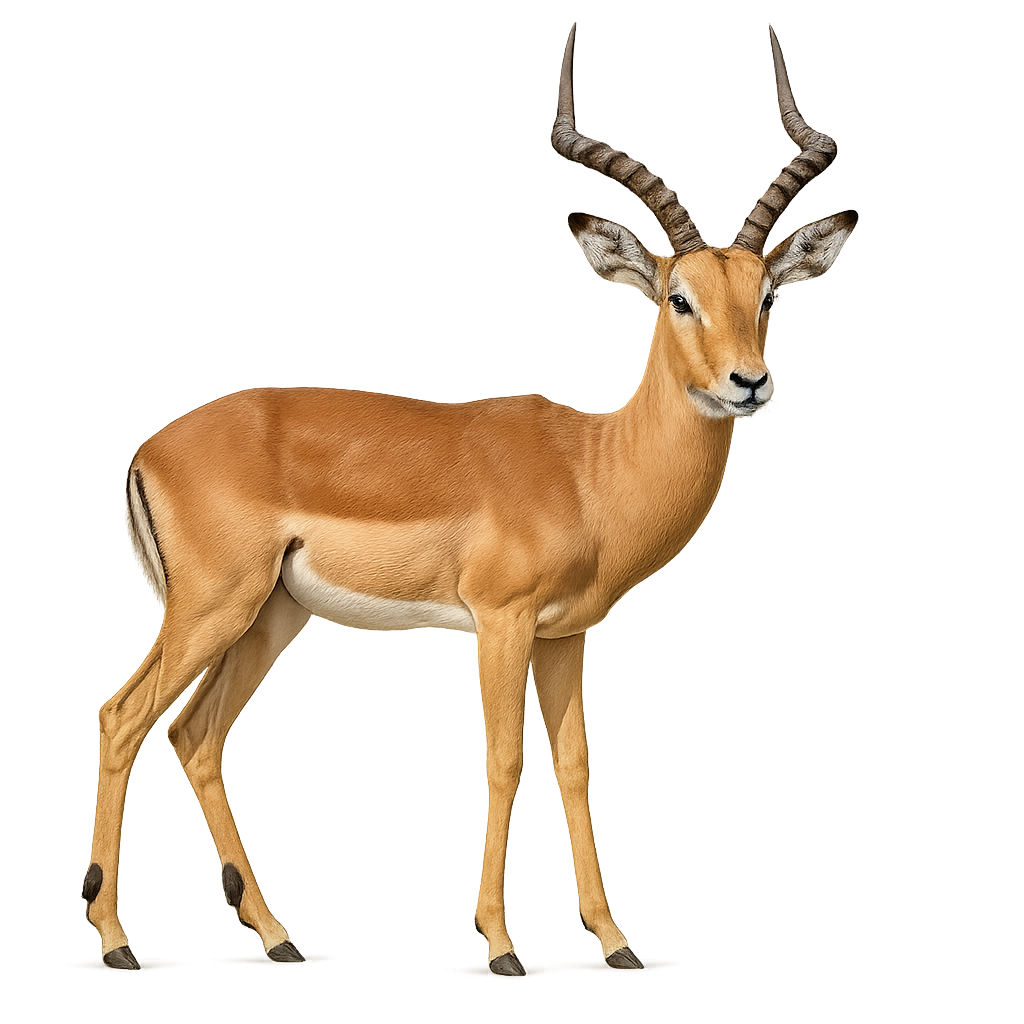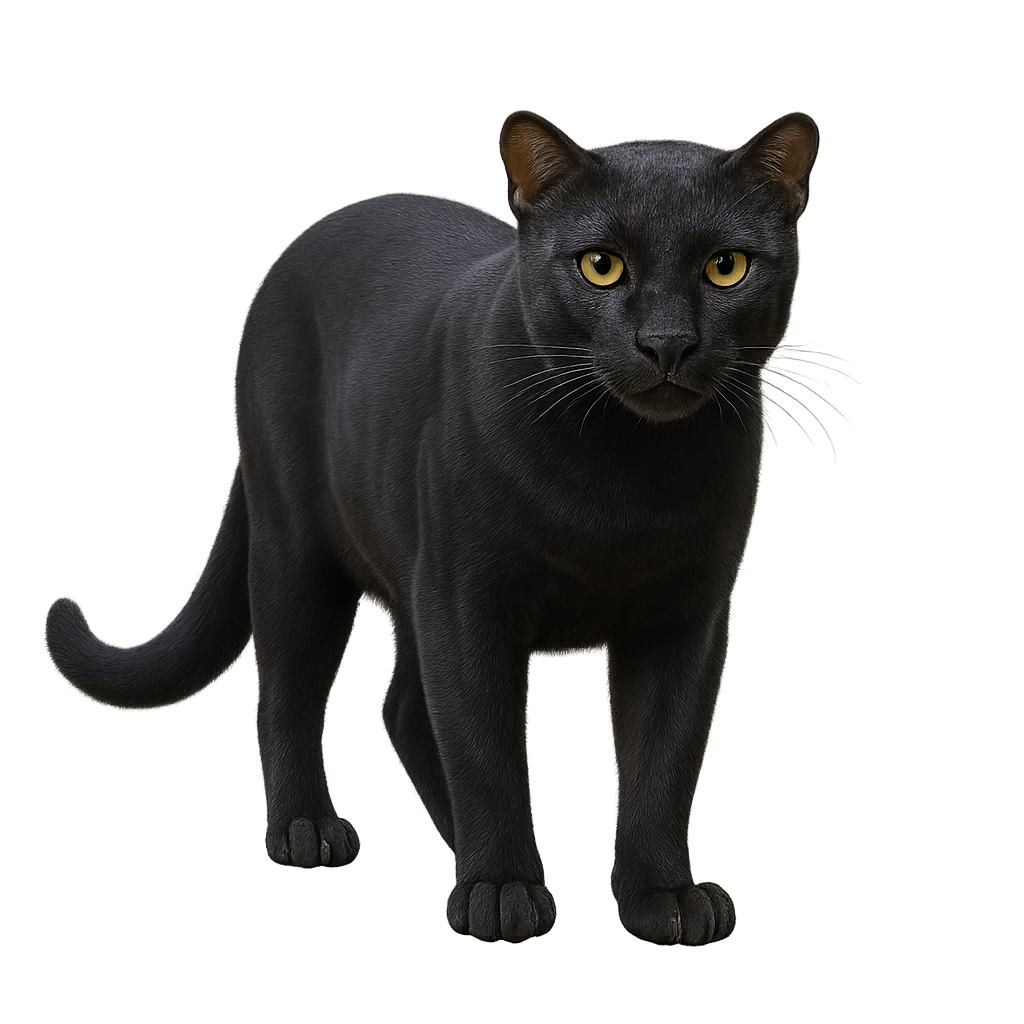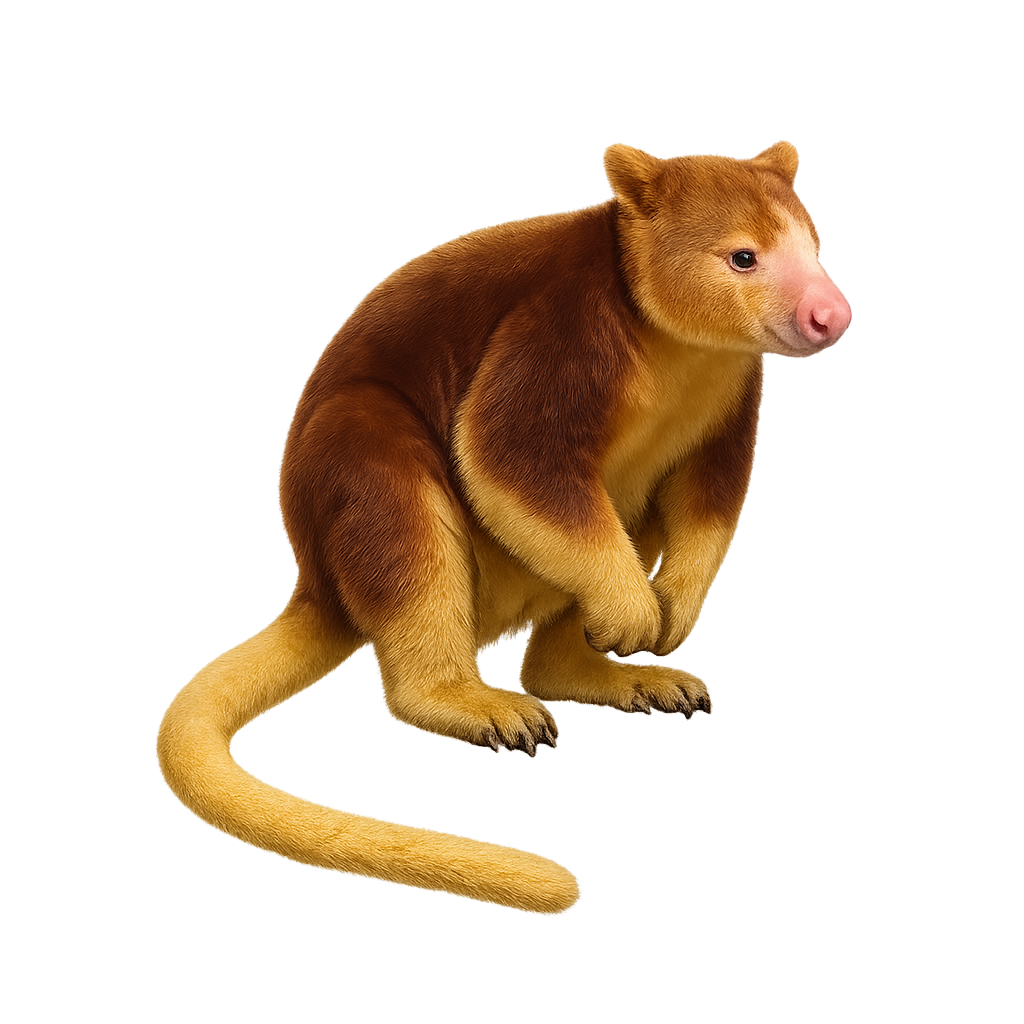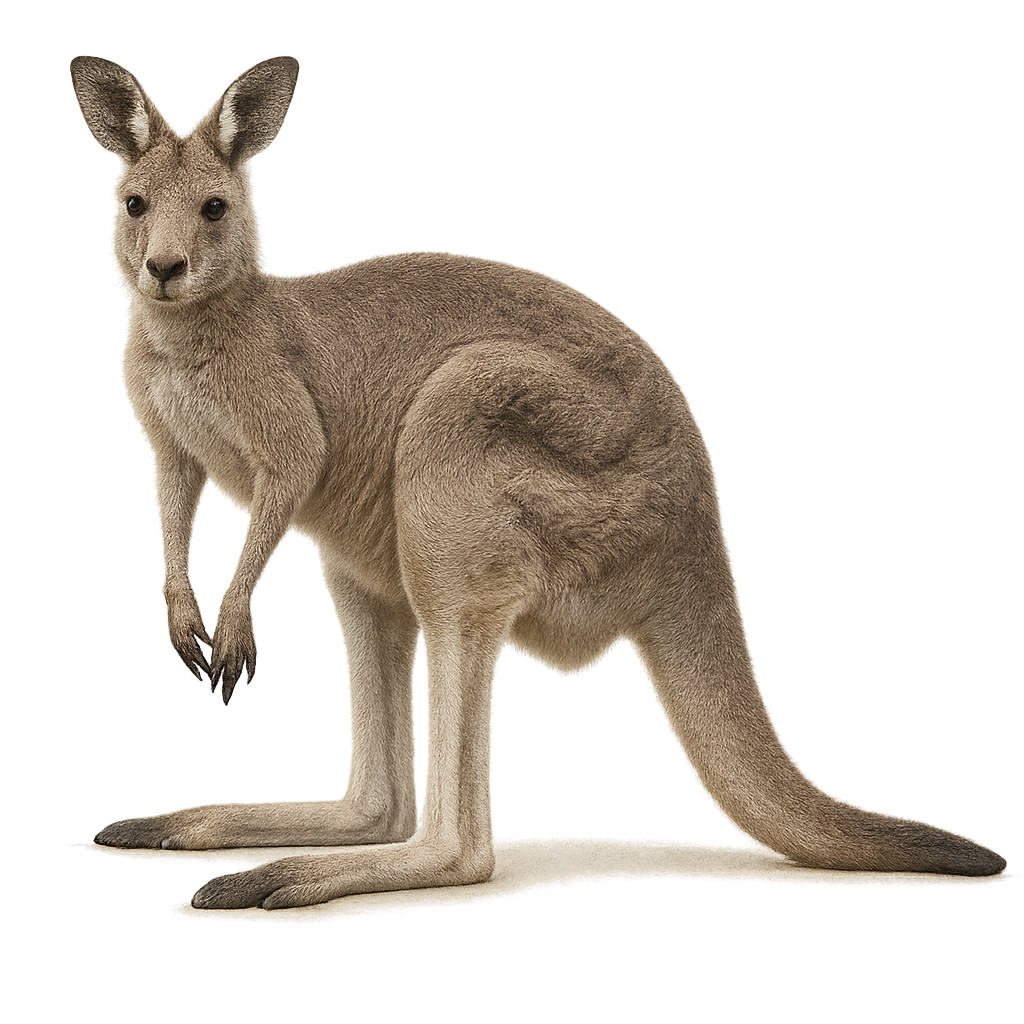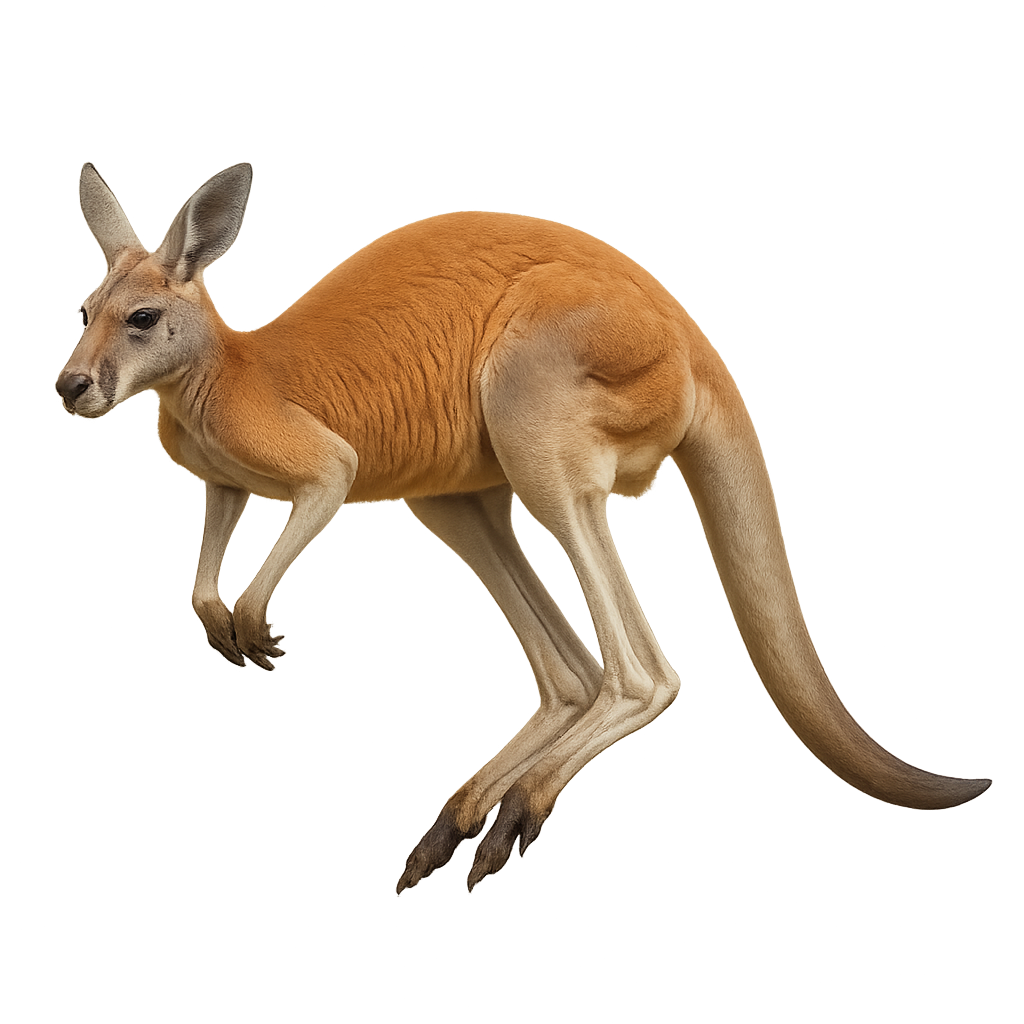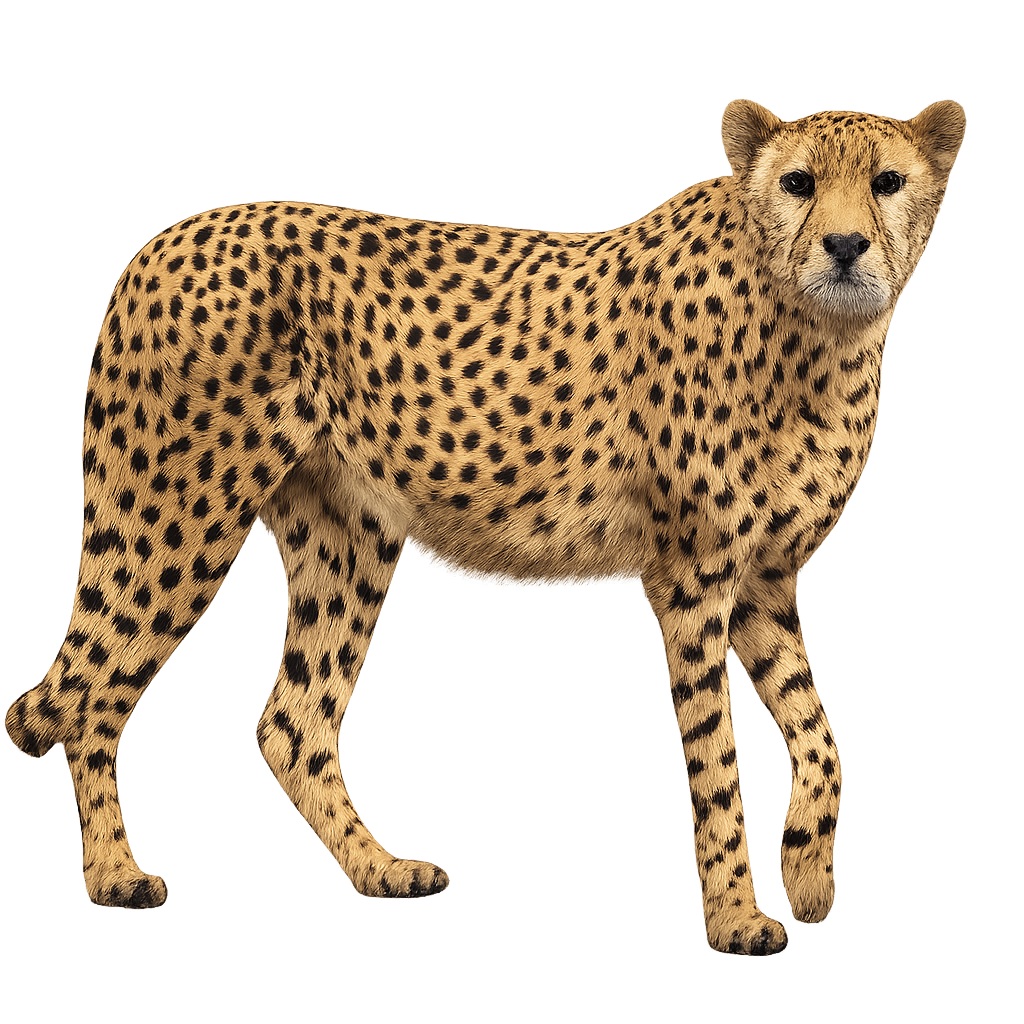
The Cheetah is a large feline known for its exceptional speed, making it the fastest land mammal. It measures about 1.1 to 1.5 meters in length, with a shoulder height of around 75 cm, and weighs between 40 and 65 kg. Its coat is short, golden to light brown with distinct black spots, allowing it to blend effectively in the savannas. It has a round head with large nostrils, sharp eyes, and distinctive black tear marks on its cheeks, which help it focus its vision while hunting. The Cheetah primarily inhabits sub-Saharan Africa, with small populations in Iran, in open habitats such as savannas, grasslands, and deserts. Carnivorous, it mainly feeds on gazelles, springboks, and other small animals. Unlike other large cats, the Cheetah hunts using speed rather than brute strength. It can reach speeds of 100 to 110 km/h in a few seconds, but this speed can only be maintained for short distances. Although the Cheetah is not critically endangered, it faces threats like habitat loss, poaching, and reduced natural prey.
The Asiatic cheetah, or Iranian cheetah, is a rare subspecies of cheetah primarily found in Iran. It is distinguished by its tawny coat with black spots and its slender, speed-adapted body. This feline is a symbol of Iranian wildlife but is critically endangered due to habitat loss, hunting, and a decrease in natural prey. Conservation efforts focus on habitat protection and raising awareness among local communities. The Asiatic cheetah is a diurnal hunter, using its incredible speed to catch prey such as gazelles and hares.
The Saharan cheetah, or Acinonyx jubatus hecki, is a rare subspecies of cheetah found mainly in the desert regions of the Sahara. It is distinguished by its pale coat and less pronounced spots, making it well-suited to its arid environment. This feline is an agile and fast predator, capable of reaching impressive speeds to catch its prey. Unfortunately, it is critically endangered due to habitat loss, hunting, and the decline of its natural prey. Conservation efforts are crucial for its survival. Solitary by nature, the Saharan cheetah is primarily active during the cooler hours of the morning and evening, avoiding the intense desert heat.
The Hartebeest is a medium-sized antelope, easily recognizable by its large lyre-shaped horns and distinctive coat. It stands about 1.1 to 1.3 meters tall at the shoulder, with a weight ranging from 90 to 150 kg. Its coat is generally reddish-brown, with characteristic white markings on the belly, legs, and around the eyes, and a darker coat on the back. The Hartebeest primarily inhabits savannas, grasslands, and grassy areas in East and Southern Africa, notably in Kenya, Tanzania, South Africa, and Namibia. Herbivorous, it primarily feeds on grasses, leaves, and young shoots. It lives in social groups, usually composed of females and young, while adult males often live alone or in small groups. While the Hartebeest is not currently endangered, it faces threats such as habitat loss, hunting, and disease.
The bushbuck, or Tragelaphus scriptus, is a small African antelope known for its brown coat adorned with white stripes and spots. Males have spiral horns, while females do not. This mammal is primarily nocturnal and crepuscular, favoring dense forests and bushy areas where it can hide from predators. It is solitary, although females may be seen with their young. The bushbuck is an herbivore, feeding on leaves, fruits, and young shoots. Its ability to remain still and silent makes it a challenging animal to observe in its natural habitat.
The hamadryas baboon, also known as the sacred baboon, is a primate species distinguished by its silver fur and the impressive mane of the males. Native to the Horn of Africa and parts of the Arabian Peninsula, it lives in complex social groups. Dominant males lead harems consisting of several females and their offspring. These baboons are diurnal and spend most of their time foraging for food, primarily fruits, seeds, and insects. Their natural habitat includes savannas, arid steppes, and rocky areas. Although they can survive in harsh environments, their population is threatened by habitat loss and hunting.
The Equus hemionus, commonly known as the onager or Asiatic wild ass, is a wild equid native to Central Asia. Adapted to arid and semi-arid environments, such as deserts and steppes, it has a light brown coat that becomes paler in winter, and a short, upright mane. Onagers are social animals that live in groups, often led by a dominant male. They primarily feed on grasses but can also consume shrubs and herbs. Although their population has declined due to hunting and habitat loss, conservation efforts are underway to protect this iconic species.
The African Pygmy Hedgehog, scientifically known as Atelerix albiventris, is a small insectivorous mammal native to sub-Saharan Africa. It is easily identifiable by its spiny back and white belly. This hedgehog measures about 15 to 25 cm in length and weighs between 300 and 600 grams. Primarily nocturnal, it feeds on insects, small invertebrates, and occasionally fruits. In captivity, it is often kept as a pet due to its compact size and generally docile nature. However, it requires specific care, including a suitable habitat and balanced diet to remain healthy.
The North African Hedgehog, Atelerix algirus, is a small insectivorous mammal found mainly in North Africa and parts of southern Europe. It is characterized by its short spines and light-colored face. This hedgehog is well adapted to arid and semi-arid climates, preferring open areas with sparse vegetation. It is primarily nocturnal, feeding on insects, small invertebrates, and occasionally fruits. Its ability to roll into a ball to protect itself from predators is well known. Although generally solitary, it can be observed in small groups during the breeding season. Its population is stable, but it is threatened by habitat loss and road collisions.
The Eastern Hedgehog, or Erinaceus concolor, is a small insectivorous mammal found primarily in Eastern Europe and Asia Minor. It is recognizable by its stiff spines covering its back, providing effective protection against predators. This hedgehog is nocturnal, spending its days resting in nests made of leaves and branches. It mainly feeds on insects, worms, and sometimes fruits. Although generally solitary, the Eastern Hedgehog can be observed in small groups during the breeding season. It is capable of hibernating during the winter months, reducing its metabolic activity to survive the cold temperatures.
The Ermine is a small carnivorous mammal of the weasel family, easily recognizable by its immaculate white winter coat, which contrasts with its black-tipped tail. It measures about 25 to 35 cm in length, with a tail that can reach up to 10 cm, and weighs between 100 and 350 g. During the summer, its coat is typically brown with a lighter belly, but it turns completely white in winter, except for the black tip of its tail. The Ermine primarily inhabits forests, grasslands, and mountainous areas across Eurasia and North America. It is an excellent hunter, feeding mainly on small mammals such as mice, voles, but also on birds and eggs. The Ermine uses its hunting skills to capture prey with great agility and speed. While it is not endangered, the Ermine can be affected by habitat loss and climate change, particularly affecting the color of its fur.
The Common Hippopotamus is a large semi-aquatic mammal, easily recognizable by its massive body and thick skin. It measures between 3.3 and 4.5 meters in length, with a weight reaching 1,500 to 1,800 kg, or more. Its body is primarily gray, with pink skin underneath the belly and ears and eyes positioned high on its head, allowing it to see and hear while submerged in water. Hippos are primarily herbivores, feeding on grass and aquatic vegetation in large quantities, mostly at night. They spend most of their time in the water to regulate their body temperature and prevent dehydration, while still being able to move quickly on land. The Common Hippopotamus primarily inhabits sub-Saharan Africa, in rivers, lakes, and swamps. Although it is a powerful and territorial animal, it is threatened by habitat loss, hunting, and conflicts with human populations.
The Pygmy Hippopotamus is a smaller species of hippopotamus, much smaller than its cousin the Common Hippopotamus, with an adult size measuring about 1.5 to 1.75 meters in length and weighing between 180 and 275 kg. Its coat is gray-olive or dark brown, with smooth and thick skin. Unlike the Common Hippopotamus, the Pygmy Hippopotamus primarily inhabits the forests of West Africa, particularly in Liberia, Sierra Leone, Guinea, and Côte d'Ivoire, and prefers shallow rivers and swamps rather than vast expanses of water. It is primarily herbivorous, feeding on aquatic vegetation and foliage, but unlike its cousin, it does not spend all its time in the water and can be more active on land. The Pygmy Hippopotamus is a nocturnal and solitary species, often elusive and difficult to observe. Although it is less exposed to threats than the Common Hippopotamus, it is still endangered due to habitat loss, hunting, and human disturbance.
The hirola, or Beatragus hunteri, is a rare and endangered antelope native to the dry savannas of Kenya and Somalia. Recognizable by its lyre-shaped horns and light brown coat, the hirola is often called the "four-eyed antelope" due to the prominent preorbital glands located under its eyes. These glands play a crucial role in olfactory communication among individuals. Hirolas live in small herds, usually consisting of females and their young, while adult males are often solitary or form small bachelor groups. This species is diurnal, feeding mainly on grasses and foliage. Unfortunately, the hirola is critically endangered, primarily due to habitat loss, hunting, and diseases transmitted by domestic livestock.
The huemul is a species of deer native to the mountains of Patagonia, in Argentina and Chile. It is distinguished by its medium size and graceful antlers. It lives in mountain forests, where it primarily feeds on plants, moss, and bark. Unfortunately, it is classified as endangered due to illegal hunting and habitat loss. The huemul is a symbol of the region's wildlife, but its populations are becoming increasingly rare.
The Alouatta caraya, commonly known as the black howler, is a primate of the Atelidae family. This monkey is easily recognizable by its black fur in males and golden brown in females. It primarily inhabits the tropical and subtropical forests of South America, notably in Brazil, Argentina, Paraguay, and Bolivia. Black howlers are famous for their powerful calls, audible over several kilometers, used to mark their territory. They live in social groups consisting of several individuals and primarily feed on leaves, fruits, and flowers. Their arboreal lifestyle makes them particularly agile in trees, although they spend much of their time resting to digest their fiber-rich diet.
The brown hyena, scientifically known as Parahyaena brunnea, is a medium-sized carnivorous mammal, primarily nocturnal, inhabiting the arid and semi-arid regions of southern Africa. It is distinguished by its long, shaggy coat, ranging from dark brown to black, with lighter stripes on its legs. Its snout is pointed, and it has large, rounded ears. Unlike other hyenas, it is mainly a scavenger, feeding on carcasses left by other predators. It lives in small family groups but often hunts alone. Although its appearance might seem intimidating, it is generally shy and avoids human interactions.
The Striped Hyena is a medium-sized carnivore, easily recognizable by its striped coat and unique behavior among hyenas. It measures about 90 cm in length, with a shoulder height of 60 cm, and weighs between 40 and 60 kg. Its coat is mainly gray or beige, with black stripes on the flanks, helping it blend into its environment. The Striped Hyena has a wide head, large ears, and an elongated muzzle, along with a short tail. Unlike the spotted hyena, the Striped Hyena is more solitary and prefers to hunt alone or in small groups. It primarily feeds on small mammals, reptiles, and insects, but is also opportunistic and a scavenger, feeding on the carcasses of dead animals. It is found mainly in North Africa, in arid and semi-arid areas such as deserts and savannas. While the Striped Hyena is not endangered, it is threatened by habitat loss and human conflict.
The Spotted Hyena is a robust carnivore, known for its complex social behavior and distinctive call. It measures between 90 and 150 cm in length, with a shoulder height of about 70 cm, and weighs between 40 and 80 kg. Its coat is characterized by black and brown spots on a yellow-gray background, giving it a unique appearance. The Spotted Hyena primarily inhabits savannas, open grasslands, and wooded areas in sub-Saharan Africa, where it forms large clans organized around a strict hierarchy. It is primarily carnivorous, feeding on large prey such as gazelles and zebras, but it is also an opportunistic scavenger, feeding on carcasses of animals killed by other predators. It is an effective hunter, using group strategies to capture prey. Although the species is relatively abundant, it is sometimes viewed negatively due to its reputation as a scavenger, but it plays an important role in ecosystems by eliminating carcasses and regulating animal populations.
The Impala is a medium-sized, slender, and graceful antelope, easily recognizable by its elegant, curved horns and its light brown to reddish coat, with a white belly and tail. It stands about 70 to 90 cm at the shoulder, with a total length of 1.2 to 2 meters, and weighs between 40 and 75 kg. Males have long, fine, lyre-shaped horns that can reach up to 90 cm in length, while females, which lack horns, are generally smaller. The Impala primarily inhabits savannas and woodland grasslands in East and Southern Africa, where it forms complex social groups. It primarily feeds on grass, but may also eat leaves and fruits when grass is less abundant. The Impala is an excellent runner, capable of making long leaps to escape its predators. Although the Impala is quite widespread, it is vulnerable to habitat loss and excessive hunting.
The Indri is one of the largest lemurs in Madagascar, known for its piercing call that echoes through the forest. With its thick fur and long arms, it primarily inhabits the tropical forests of eastern Madagascar. The Indri feeds mainly on leaves, fruits, and flowers, and remains loyal to a small territory which it defends with its songs. Due to deforestation and poaching, the Indri is critically endangered.

The Pyrenean Chamois, or Rupicapra pyrenaica, is a medium-sized ungulate, easily recognizable by its reddish-brown coat and curved horns. It measures about 70 to 80 cm at the shoulder, with a length of 1 to 1.2 meters, and weighs between 25 and 50 kg. Its body is compact and robust, adapted for mountainous terrain, with long and powerful legs, perfect for moving on steep slopes. The Pyrenean Chamois primarily inhabits the mountains of the Pyrenees, the northern region of Spain, and southern France. It prefers rocky slopes and wooded areas, where it feeds mainly on grasses, plants, berries, and young shoots. The Pyrenean Chamois is a shy and elusive animal, living in family groups during the winter, but often separating into small groups or remaining solitary during the summer. Although the species nearly disappeared in the early 20th century, conservation efforts have led to its recovery. The Pyrenean Chamois is currently classified as a species of least concern, but it remains vulnerable to hunting and habitat loss.
The Jaguar is a large, robust, and powerful feline, easily recognizable by its spotted coat, characterized by dark rosettes on a golden or yellow background. It measures between 1.2 and 1.8 meters in length, with a tail of 60 to 80 cm, and weighs between 45 and 100 kg, with males generally being larger than females. Its body is massive and muscular, adapted for hunting in a variety of environments, from tropical forests to savannas. The Jaguar possesses one of the most powerful jaws in the animal kingdom, capable of piercing the thick skin of its prey, such as capybaras, deer, and even reptiles like caimans. It is also capable of swimming and often hunts aquatic animals. This feline primarily inhabits Central and South America, from southern Mexico to Argentina, preferring tropical forests, swamps, and riparian zones. While the species is still relatively widespread, it is threatened by deforestation, illegal hunting, and habitat loss.
The jaguarundi is a slender wild cat of 50–60 cm (excluding tail), with short legs and uniform grey or reddish coat. A secretive, diurnal species, it inhabits tropical and deciduous forests, scrub and riparian thickets, preying on ground-feeding birds, small rodents and reptiles.
The Kangaroo is an iconic marsupial, famous for its large size, powerful hind legs, and long tail. It typically measures between 1 and 1.8 meters in length, with a tail length of 80 to 100 cm, and can weigh between 18 and 90 kg, depending on the species. Its coat varies depending on the species but is generally gray or red, with dense fur that protects it from the extreme temperatures of Australia. The Kangaroo is an excellent jumper, capable of covering large distances with its powerful hind legs and its tail, which serves as a counterbalance when it moves. Herbivorous, it primarily feeds on grass, leaves, and young shoots. Kangaroos primarily inhabit open plains, forests, and savannahs in Australia. They are social animals, often living in groups called "mobs," although they can also be solitary. While the species is not endangered, it is sometimes threatened by habitat loss, bushfires, and competition with livestock.
Matschie’s tree kangaroo is a medium-sized marsupial, 60–80 cm long (excluding tail), with reddish-brown fur and a long prehensile tail. Endemic to humid montane rainforests of the Huon Peninsula in Papua New Guinea (1000–3000 m), it spends most of its time in the canopy feeding on fruits, leaves, and insects. Solitary and elusive, it moves nimbly among branches thanks to strong limbs and a long tail.
The Eastern Grey Kangaroo, or Macropus giganteus, is a prominent marsupial native to Australia, recognized for its large size and unique hopping locomotion. It has a grey-brown coat with a lighter belly. Males can reach up to 2 meters in height and weigh around 66 kg, while females are generally smaller. These kangaroos live in groups known as "mobs" and are primarily herbivorous, feeding on grasses and leaves. They possess powerful hind legs and a muscular tail used for balance. Although they are mostly active at dusk and dawn, they can also be seen during the day.
The Red Kangaroo is one of the most iconic and largest species of kangaroos in Australia. It is easily recognizable by its red-brown fur and large size, with adult males reaching over 2 meters in length, including their tail. The Red Kangaroo lives in the dry and semi-arid regions of the Australian Outback, where it primarily feeds on grasses and plants. This animal is an excellent jumper and uses its powerful hind legs to travel at high speeds, often performing impressive leaps. While it is mainly active at dusk and dawn, it can also adapt to the extreme temperatures of its environment.
The Kiang is a large wild equid, closely related to the horse, primarily found in the high plateaus and mountains of the Himalayas and Tibet. It stands about 1.3 to 1.5 meters at the shoulder and weighs between 300 and 400 kg. Its coat is typically brownish-red or gray-brown with lighter shades on the belly and around the legs, and it has a short and sparse mane. The Kiang has a broad head and a bushy tail, similar to that of a horse. It primarily inhabits arid regions and high-altitude grasslands, feeding on grasses and woody plants. Highly social, the Kiang lives in large groups that move together in search of food. Unlike other wild equids, it is more tolerant of cold conditions and can survive at extremely high altitudes, up to 5,000 meters. While the species is relatively abundant in its range, it can be threatened by habitat loss due to climate change and human pressure, particularly from grazing and hunting.
Koala
Phascolarctos cinereus
The Koala is an iconic tree-dwelling marsupial from Australia, easily recognizable by its grey-silver fur, large round ears, and heart-shaped black nose. It measures about 60 to 85 cm in length and weighs between 4 and 15 kg, with males generally being larger than females. The Koala has powerful claws adapted for its tree-dwelling lifestyle, spending almost its entire life in trees and feeding primarily on eucalyptus leaves. Its diet is very specific, and while eucalyptus is an abundant food source, it is also toxic to most other animals, providing the Koala with some degree of protection from predators. The Koala is a nocturnal and solitary animal, spending the majority of the day sleeping in trees, seeking refuge in Australia's forested areas. It is a symbol of Australian wildlife, but its habitat is threatened by deforestation, bushfires, and disease, which has led to a decline in its population. Conservation efforts are underway to protect this marsupial and its natural habitat.




